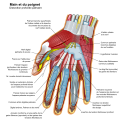Fichier:Wrist and hand deeper palmar dissection-numbers.svg

Gréisst vun dëser PNG-Duerstellung vun dësem SVG-Fichier: 474 × 600 Pixel. Aner Opléisungen: 190 × 240 Pixel | 379 × 480 Pixel | 607 × 768 Pixel | 809 × 1.024 Pixel | 1.619 × 2.048 Pixel | 555 × 702 Pixel.
Original-Fichier (SVG-Fichier, Basisgréisst: 555 × 702 Pixel, Gréisst vum Fichier: 207 KB)
Versiounen
Klickt op e bestëmmten Zäitpunkt fir déi respektiv Versioun vum Fichier ze kucken.
| Versioun vum | Miniaturbild | Dimensiounen | Benotzer | Bemierkung | |
|---|---|---|---|---|---|
| aktuell | 17:15, 1. Jun. 2015 |  | 555 × 702 (207 KB) | Perhelion | optimize image |
| 11:42, 8. Jul. 2012 |  | 555 × 702 (399 KB) | Wilfredor | optimize image | |
| 21:11, 13. Jan. 2009 |  | 555 × 702 (817 KB) | Wilfredor | {{Information |Description= |Source= |Date= |Author= |Permission= |other_versions= }} | |
| 16:37, 16. Okt. 2008 |  | 555 × 702 (815 KB) | Wilfredor | {{Information |Description= |Source= |Date= |Author= |Permission= |other_versions= }} | |
| 19:33, 23. Jul. 2008 |  | 770 × 767 (822 KB) | Bibi Saint-Pol | {{Created with Inkscape}} == {{int:filedesc}} == {{Information |Description= {{en|The hands (med./lat.: manus, pl. manūs) are the two intricate, prehensile, multi-fingered body parts normally located at the end of each arm of a human or other primate. Th |
Benotze vu Fichieren
Dës Säite benotzen dëse Fichier:
Globaalt Benotze vum Fichier
Dës aner Wikie benotzen dëse Fichier:
- Benotzt op af.wikipedia.org
- Benotzt op ar.wikipedia.org
- Benotzt op az.wikipedia.org
- Benotzt op bjn.wikipedia.org
- Benotzt op bn.wikipedia.org
- Benotzt op br.wikipedia.org
- Benotzt op ce.wikipedia.org
- Benotzt op crh.wikipedia.org
- Benotzt op cv.wikipedia.org
- Benotzt op da.wikipedia.org
- Benotzt op de.wikipedia.org
- Benotzt op en.wikipedia.org
- Wikipedia:Featured picture candidates/Wrist and hand deeper palmar dissection-en.svg
- Wikipedia:Featured picture candidates/April-2009
- User:Madhero88/Medicalg
- Wikipedia:WikiProject Anatomy/Resources
- Wikipedia talk:WikiProject Anatomy/Archive 9
- User talk:Rhododendrites/Reconsidering FPC on the English Wikipedia
- Benotzt op es.wikipedia.org
- Benotzt op fa.wikipedia.org
- Benotzt op fr.wikipedia.org
- Benotzt op hr.wikipedia.org
- Benotzt op hu.wikipedia.org
- Benotzt op id.wikipedia.org
- Benotzt op incubator.wikimedia.org
- Benotzt op iu.wikipedia.org
- Benotzt op ko.wikipedia.org
- Benotzt op lbe.wikipedia.org
- Benotzt op lt.wikipedia.org
- Benotzt op ms.wikipedia.org
- Benotzt op nia.wiktionary.org
- Benotzt op os.wikipedia.org
- Benotzt op pl.wikipedia.org
- Benotzt op pt.wikipedia.org
- Benotzt op ru.wikipedia.org
- Benotzt op ru.wikimedia.org
Kuckt globale Gebrauch vun dësem Fichier.






